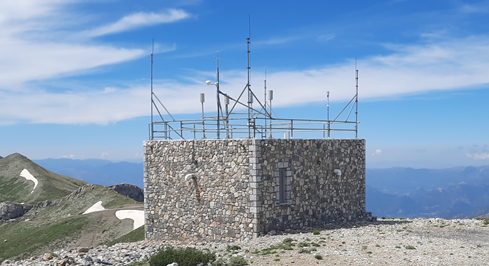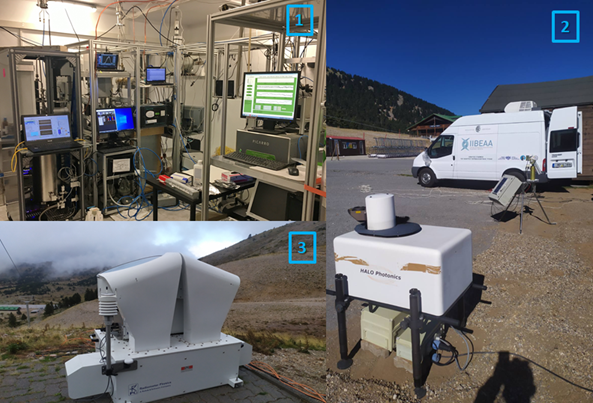Cloud-AerosoL InteractionS in the Helmos Background TropOsphere (CALISHTO)
Published: 17, December, 2021

Cloud-AerosoL InteractionS in the Helmos Background TropOsphere (CALISHTO)
PANACEA/ACTRIS -HELMOS station – a PANACEA-PyroTRACH Campaign
October-November 2021
Coordinators: K. Eleftheriadis, A. Papayannis, A.Nenes

The Cloud-AerosoL InteractionS in the Helmos Background TropOsphere (CALISHTO) Campaign has been successfully conducted in October - November 2021. It is a synergy between the PANhellenic infrastructure for Atmospheric Composition and climatE chAnge (PANACEA) project focusing on WorkPackage 9 (WP9): Aerosol Cloud Interactions (ACI) and the European Research Council (ERC) Pyrogenic TRansformations Affecting Climate and Health (PyroTRACH) Project. The campaign is centered around the NCSR Demokritos ACTRIS station, Helmos Mt (HAC), located at 2315 meters above sea level, the southernmost aerosol-in situ high altitude ACTRIS station above 2000 meters in Europe at the Peloponnese Helmos (Aroania) mountain, Greece. During the two-month intensive, additional instruments from EPFL Switzerland, NTUA Greece and as many as 15 Greek and International partners were deployed at the station, at a lower site 500 meters below and one more site at the CSTACC center near the city of Patras, Greece - adding the capacity for cloud-in situ, cloud remote sensing and aerosol remote sensing measurements.

Motivation
Cloud processes control precipitation and the hydrological cycle, which have a direct impact on the supply of freshwater that affects ecosystems and agriculture. Despite their importance, the treatment of clouds in climate models carries large uncertainties that directly affect climate model predictions, (Seinfeld et al., 2016). Especially uncertain and important are the impacts of aerosols on mixed-phase clouds, given the many processes that occur involving liquid water and ice. Observed ice crystal number concentrations (ICNC) in clouds can be orders of magnitude higher than expected from observed IN concentrations, from the action of Secondary Ice Processes (SIP), where ice crystals (formed upon IN) collide with other cloud droplets/crystals and splinter into many (secondary) ice crystals. These processes are expected to occur in many types of orographic clouds and affect their precipitation rates and properties (e.g., Georgakaki et al., in review). The Mt.Helmos site is a background site that mostly resides in the free troposphere or at the interface with the Planetary Boundary Layer (PBL) with very low influence from the surface polluted layers (Collaud-Coen et al., 2019) and is influenced by a wide range of air-mass types (continental, Saharan, long-range biomass burning, continental outflow, volcanic aerosol, etc.).

Key goals
- Study aerosol-cloud interactions for orographic mixed-phase clouds in the Eastern Mediterranean region using synergy of remote sensing, in-situ instrumentation and an hierarchy of models.
- Improve remote sensing algorithms to retrieve cloud microphysical properties (e.g. cloud droplet number concentrations).
These goals will be addressed through:
- Observing the dynamics of the airmasses near the region of cloud formation
- Understanding the sources (local vs. regional scale; bioaerosols, dust, volcanoes, pollution, biomass burning, marine aerosol) and drivers of the aerosol population (new particle formation, secondary organic aerosol formation and cloud processing.
- Determining aerosol optical properties, CCN, IN concentrations, Cloud microphysical properties (droplet and ice size distributions) and their links
- Modeling of the aerosol-cloud links and their impacts from local to regional scales

A unique component of the CALISHTO experimental Campaign is to track and study a large number of orographic cloud events, influenced by a combination of boundary layer and free tropospheric aerosol, to: (i) Characterize and link the dynamics and microphysics of cloud cycles, (ii) Quantify environmental thermodynamic and kinematic controls on cloud life cycle properties, (iii) Isolate and quantify the impacts of aerosol on clouds at the interface between the PBL and the free troposphere.
Preliminary results and prospects
The aerosol origin and their properties during the campaign are the first things being explored in the CALISHTO dataset. Preliminary results show a wealth of information arising from the combined output of in-situ and remote sensing data. Examples of two interesting cases for the aerosol types encountered are given in Figures 3 and 4, which present a first overview of aerosol and cloud-relevant properties during 6-7 November, 2021.
The case of polluted layers or plumes identified by the LIDAR to rise at the Helmos site altitude are also identified on the 6th of November by a rise in scattering and absorption as well as time resolved aerosol organics causing a drop in particle hygroscopicity.

On the next day a Saharan dust layer is identified by the LIDAR and a rise in aerosol optical parameters as well as a rarely observed increase of bioaerosol (Figure 4, left middle plot) and Ice Nucleating Particles measured by the Portable Ice Nucleation Experiment (PINE) (Figure 4, right middle plot). The aerosol number size distribution also shows that apart from the coarse mode increases (Figure 4, left plot red trace) the accumulation and Aitken mode number concentration (top plot red trace) increases relative to background conditions. Although the intensive campaign was initially planned for 60 days, the coordinators have agreed to extend the duration of the campaign and Helmos in-situ INPs - PINE
continue measurements throughout Winter and Spring of 2022, despite the challenging and extreme Alpine weather conditions on-site. Measurements will be carried out with a reduced suite of instrumentation which includes all the Near Real Time capacity of HAC, the EPFL Cloud Radars, CCN and WIBS, the KIT PINE, the FMI HALO, as well as the usual long term operation programme by NCSR Demokritos. The continuation of INP and other cloud in situ measurements at Mt. Helmos will also be of importance for the further implementation of the ACTRIS Topical Center for Cloud In-Situ Measurements (TC CIS) and the related network of ACTRIS National Facilities (NFs).
Acknowledgments
We acknowledge funding and support by:
- the “PANhellenic infrastructure for Atmospheric Composition and climatE change” (MIS 5021516), which is implemented under the Action “Reinforcement of the Research and Innovation Infrastructure”, funded by the Operational Programme “Competitiveness, Entrepreneurship and Innovation” (NSRF 2014–2020) and co-financed by Greece and the European Union (European Regional Development Fund)
- the European Research Council, CoG-2016 project PyroTRACH (726165) H2020-EU.1.1. – Excellent Science.
- the EU ACTRIS-IMP H2020 project ID 871116
References
Collaud Coen, M., Andrews, E., Aliaga, D., Andrade, M., Angelov, H., Bukowiecki, N., Ealo, M., Fialho, P., Flentje, H., Hallar, A. G., Hooda, R., Kalapov, I., Krejci, R., Lin, N.-H., Marinoni, A., Ming, J., Nguyen, N. A., Pandolfi, M., Pont, V., Ries, L., Rodríguez, S., Schauer, G., Sellegri, K., Sharma, S., Sun, J., Tunved, P., Velasquez, P., and Ruffieux, D.: Identification of topographic features influencing aerosol observations at high altitude stations, Atmos. Chem. Phys., 18, 12289–12313, https://doi.org/10.5194/acp-18-12289-2018
Georgakaki, P., Sotiropoulou, G., Vignon, É., Billault-Roux, A.-C., Berne, A., and Nenes, A.: Secondary ice production processes in wintertime alpine mixed-phase clouds, Atmos. Chem. Phys. Discuss. [preprint], https://doi.org/10.5194/acp-2021-760, in review, 2021
Seinfeld, J.H., Bretherton, C.S., Carslaw, K.S., Coe, H., DeMott, P.J., Dunlea, E.J., Feingold, G., Ghan, S.J., Guenther, A.B., Kahn, R.A., Kracunas, I.P., Kreidenweis, S.M., Molina, M.J., Nenes, A., Penner, J.E., Prather, K.A., Ramanathan, V., Ramaswamy, V., Rasch, P.J., Ravishankara, A.R., Rosenfeld, D., Stephens, G., Wood R. (2016) Improving Our Fundamental Understanding of the Role of Aerosol-Cloud Interactions in the Climate System, Proc. Nat. Acad. Sci., 113, 21, 5781-5790, doi: 10.1073/pnas.1514043113
For more information:
Dr. Kostas Eleftheriadis, National Center for Scientific Research Demokritos, elefther@ipta.demokritos.gr
Prof. Alex Papayannis, National Technical University of Athens (NTUA), apdlidar@central.ntua.gr
Prof. Athanasios Nenes, Ecole Polytechnique de Lausanne (LAPI/EPFL) and the Center for the Study of Air Quality and Climate Change, Foundation for Research and Technology Hellas (CSTACC/FORTH), athanasios.nenes@epfl.ch